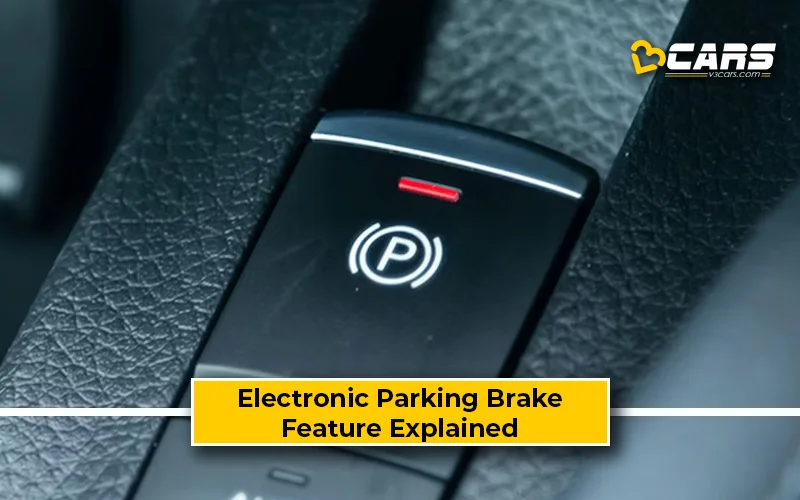Electronic Parking Brake – Feature Explained
The traditional handbrake lever, a familiar sight in cars for decades, is steadily being replaced by a more modern and convenient alternative: the Electronic Parking Brake (EPB). This technology brings enhanced functionality, increased safety, and contributes to a cleaner, more ergonomic cabin design.

What Is An Electronic Parking Brake?
An Electronic Parking Brake (EPB) is an advanced system that replaces the manual handbrake lever with an electronically controlled mechanism. It allows the driver to engage and release the parking brake with the simple press or pull of a button or switch, typically located on the centre console.
How Does An Electronic Parking Brake Work?
The operation of an EPB is managed by the vehicle’s electronic control unit (ECU) and electric motors:
- Button Activation: When the driver activates the EPB by pressing or pulling its designated button, the ECU receives a signal.
- Motor Engagement: The ECU then commands small electric motors, usually located at the rear brake calipers, to engage. These motors physically apply the brake pads against the discs, securing the vehicle. The system often provides an audible confirmation or tactile feedback.
- Automatic Release: A key advantage of the EPB is its intelligent automatic release function. When the driver puts the car into gear and presses the accelerator pedal (or releases the clutch in a manual transmission car), the system detects the driver’s intent to move and automatically disengages the parking brake smoothly.
- Optional Auto-Engagement: Many EPB systems can be configured to automatically engage the parking brake when the ignition is turned off, or when the driver’s seatbelt is unbuckled and the door is opened, adding an extra layer of safety.
- Emergency Braking: In an emergency situation, holding the EPB button down typically activates the vehicle’s primary braking system (integrated with ABS/ESC) to bring the car to a controlled stop, even at speed.
What Are The Pros And Cons Of An Electronic Parking Brake?
Here are the pros, or advantages, of an Electronic Parking Brake:
- Space Saving: Eliminating the large handbrake lever frees up valuable real estate on the centre console, allowing for more storage compartments or other cabin features.
- Enhanced Convenience: Automatic engagement and disengagement streamline driving, particularly in stop-and-go traffic, reducing driver effort.
- Seamless Integration: It often works hand-in-hand with features like Auto Hold and Hill Start Assist, simplifying driving and boosting safety on inclines.
- Consistent Application: The EPB provides a consistent and optimal braking force every time, unlike manual handbrakes where force can vary.
- Modern Aesthetics: Contributes to a cleaner, more contemporary, and clutter-free interior design.
Here are the cons, or disadvantages, of an Electronic Parking Brake:
- Different Feel: Drivers accustomed to the mechanical feedback of a traditional handbrake might initially miss that direct, physical engagement.
- Electronic Reliance: As a fully electronic system, it relies on the vehicle’s electrical components, though modern EPB systems are built with high reliability.
- Repair Complexity: In the rare event of a malfunction, repairs can be more complex and potentially costlier compared to a simple mechanical handbrake.
- Emergency Braking Operation: The emergency braking function operates differently, often engaging through the main brakes rather than a direct mechanical lock.
Can An Electronic Parking Brake Be Installed From The Aftermarket?
Installing a full Electronic Parking Brake system from the aftermarket is highly complex and generally not recommended. The EPB is a deeply integrated, safety-critical system connected to the vehicle’s main electronic control unit (ECU), braking system hydraulics, wheel speed sensors, and other safety features like ABS and ESC. Retrofitting such a system accurately and safely would require extensive modifications to the car's core electronics and hardware, making it technically challenging, extremely costly, and potentially unsafe if not done precisely to manufacturer specifications.
Affordable Cars In India That Offer An Electronic Parking Brake?
The Electronic Parking Brake, once a luxury car exclusive, has steadily become available in more accessible segments in India, especially in higher variants of popular B2-segment SUVs and C-segment sedans. Here are a few cars and SUVs that offer an Electronic Parking Brake in India:
- Mahindra XUV 3XO
- MG Hector
- Tata Harrier
- Tata Safari
- Hyundai Creta
- Kia Seltos
- Hyundai Verna
Availability can vary based on the specific model year and trim level, so it’s always advisable to verify the features with the manufacturer or dealership for the most accurate information.
Also Read: 6 SUV Alternatives To The Tata Nexon In 2025
Helpful Tools:
- Fuel Cost Calculator for Cars – Know your monthly fuel expense based on usage and mileage
- Car On-Road Price Calculator – Convert ex-showroom to on-road price for any city
Sell Used Car Online – Enter your car and contact details to get an instant price estimate and book a free inspection with our partner network


0 Comments